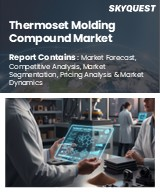
|
시장보고서
상품코드
1661206
페놀 시장 보고서 : 최종 용도별, 지역별(2025-2033년)Phenol Market Report by End-Use (Bisphenol A, Phenolic Resins, Caprolactam, Alkyl Phenyls, and Others), and Region 2025-2033 |
||||||
세계의 페놀 시장 규모는 2024년 244억 달러에 달했습니다. IMARC Group은 2025년부터 2033년까지의 성장률(CAGR)은 3.8%에 이르며 2033년에는 347억 달러에 달할 것으로 예측했습니다. 다양한 세정·제균 제품 수요 증가, 바이오 방부제로서의 이용 증가, 도료·접착제·코팅제에의 배합 증가가 시장을 견인하는 주요 요인의 일부입니다.
다양한 최종 이용 산업에서 페놀 수요 증가가 시장 성장을 가속
페놀은 범용성이 높고 가격도 저렴하기 때문에 산업용도가 다양화되어 시장 성장을 뒷받침하고 있습니다. 세계 가처분 소득이 증가하고 개인의 라이프 스타일 패턴이 변화한다는 경제 개혁은 다양한 최종 이용 산업에서 페놀 수요를 크게 자극하고 있습니다. 세계의 다양한 주택 아파트, 도로 및 고속도로 건설이 증가함에 따라 페놀 수요가 촉진되고 있습니다.
퍼스널케어 제품에서의 이용 확대
페놀은 또한 질병의 확산을 방지하기 위해 가정 및 다양한 상업시설에서 용매 및 세척제로 사용됩니다. 페놀은 유기물에 대한 침투력이 높기 때문에 다양한 전자기기 및 산업기계의 세정제로 사용되고 있습니다. 또한, 위생 상태를 유지하고 구취와 체취의 발생을 방지하기 위해 다양한 개인 관리 제품의 제조에서 페놀 수요 증가가 시장 성장을 가속하고 있습니다. 페놀은 또한 플라스틱을 생산하는 플라스틱 산업과 일치 막대 및 전기 전지 제조에 필수적인 성분인 피크린산과 같은 다양한 화약의 제조에 필수적인 원료로도 사용됩니다. 의약품 및 산화방지제의 제조에 있어서 원료로서의 페놀의 이용이 확대되고 있는 것은 유리한 시장 전망을 초래하고 있습니다. 게다가 클레오소트와 같은 목재 방부제의 주성분으로서 페놀의 채용이 증가하고 있는 것도 시장의 성장을 뒷받침하고 있습니다.
시장 경쟁에 대한 인사이트
페놀 시장은 세분화된 시장으로 크고 작은 다양한 기업들이 진입하고 있습니다. 고액의 설비투자가 필요함, 제조업체가 규모의 경제를 획득할 필요가 있는 것, 유통망에의 접근이 용이하다는 점에서 페놀 업계에서는 신규 진입의 움직임은 완만합니다. 게다가 이 시장은 제품의 차별화율이나 스위칭 비용이 낮다는 특징도 있습니다.
이 보고서는 시장 구조, 주요 기업의 시장 점유율, 주요 기업 시장 상황 분석, 주요 성공 전략, 경쟁 대시 보드, 기업 평가 사분면 등의 경쟁 분석을 수행합니다. 또한 주요 기업의 상세 프로파일도 제공합니다.
페놀이란?
페놀은 방향족 화합물이며 실온에서 백색의 결정질입니다. 강한 수소 결합으로 구성되어 있기 때문에 알코올보다 물에 녹기 쉽고 유사한 분자량의 다른 탄화수소에 비해 비등점이 높습니다. 성질은 약산성이고 가성이며 무색 액체 또는 백색 고체로 존재합니다. 빛에 닿으면 서서히 짙어지고 특징적인 달콤한 냄새가납니다. 페놀은 초기에 벤젠의 설폰화 및 염소화를 포함하는 합성 공정에서 제조되었습니다. 현재는 벤젠과 프로파일렌을 쿠멘으로 변환하고, 그것을 산화시켜 쿠멘 하이퍼옥사이드로 하고, 가수분해하여 페놀을 생성함으로써 제조되고 있습니다.
페놀의 주요 용도
페놀은 n-헥실 레조르시놀로 시판되고 있으며 기침, 시럽 및 기타 방부제에 잘 배합되어 있습니다. 또한 부틸 히드 록시 톨루엔(BHT)의 합성에도 사용됩니다. BHT는 비독성이며 다양한 식품에 포함되는 일반적인 산화 방지제입니다. 구강세정제나 가정용 세제에 배합되어 다양한 질병을 일으키는 미생물의 증식을 억제합니다. 또한 조류, 세균, 진균류 등의 누메리 생성 미생물을 죽이기 위해 사용되는 광역 항균 살충제인 살누메리제로 이용되는 경우도 많습니다. 페놀은 다양한 미술 공예 용품, 바디 페인트, 반짝임 및 기타 놀이 화장품의 제조에 사용됩니다. 또한 제약 업계에서는 백신의 효율을 유지하기위한 방부제로 사용됩니다. 또한 경구 진통제, 목과 코 스프레이, 롤 손톱 수술제 제조에도 사용됩니다. 비누, 데오도란트제, 발한제, 샴푸, 치약, 화장수 등 다양한 퍼스널케어 제품의 부드러운 방부제로 이용되고 있습니다. 또한, 보행에 지장을 초래하는 근육 경련의 발생을 방지하기 위해 근육에 주사됩니다. 게다가 입수가 용이하고 비용 효과적이며 대량으로 구입할 수 있기 때문에 페놀 수요는 세계적으로 높아지고 있습니다.
페놀 시장의 성장을 가속하는 주요 동향 :
현재 대중의 건강 의식이 높아짐에 따라 다양한 세척 및 소독 제품에 대한 수요가 증가하고 있는 것이 시장에 긍정적인 영향을 미치는 주요 요인 중 하나입니다. 이에 더하여 열경화성 플라스틱의 생산에 페놀 수지의 이용이 증가하고 있는 것도 시장의 성장을 뒷받침하고 있습니다. 또한 세계 페놀 제조에 필요한 원재료 가격이 하락하고 있습니다. 이것은 페놀의 대체품이 제한되어 있음과 함께 시장 성장에 기여합니다. 이와는 별도로, 오래된 각질을 제거하고 피부 질감을 부드럽게 하는 화학 필링과 같은 다양한 스킨케어 제품의 제조에 있어서의 페놀 수요 증가가 양호한 시장 전망을 가져오고 있습니다. 또한, 신선한 과일 및 채소의 항산화력과 항균력을 높이기 위한 생물보존제로서의 페놀화합물의 이용이 증가하고 있는 것도 시장의 성장을 지지하고 있습니다. 게다가, 페인트, 접착제 및 코팅제에 대한 페놀의 배합이 증가하고 있는 것도 시장 성장을 뒷받침하고 있습니다. 게다가 다양한 소모품과 신선품의 맛과 품질을 유지하기 위한 식음료(F&B) 업계에서 보존료 수요 증가가 시장 성장을 가속하고 있습니다.
이 보고서에서 다루는 주요 질문
- 페놀 시장 규모는?
- 페놀 수요 전망은?
- 세계의 페놀 시장의 주요 업계 동향은?
- 세계의 페놀 시장에 대한 COVID-19의 영향은?
- 세계의 페놀 시장의 최종 용도별 내역은?
- 세계의 페놀 시장의 주요 지역은?
- 페놀의 최대 제조업체는 어딘가?
목차
제1장 서문
제2장 조사 범위와 조사 방법
- 조사의 목적
- 이해관계자
- 데이터 소스
- 1차 정보
- 2차 정보
- 시장 추정
- 상향식 접근
- 하향식 접근
- 조사 방법
제3장 주요 요약
제4장 서론
- 개요
- 물리적 및 화학적 특성
- 주요 업계 동향
제5장 세계의 페놀 산업
- 시장 개요
- 시장 실적
- 수량 동향
- 금액 동향
- 가격 분석
- 주요 가격 지표
- 가격구조
- 가격 동향
- 시장 분석 : 지역별
- 시장 내역 : 최종 용도별
- 시장 예측
- SWOT 분석
- 개요
- 강점
- 약점
- 기회
- 위협
- 밸류체인 분석
- 원재료 조달
- 제조
- 유통
- 수출
- 최종 용도
- Porter's Five Forces 분석
- 개요
- 구매자의 협상력
- 공급기업의 협상력
- 경쟁도
- 신규 진입업자의 위협
- 대체품의 위협
- 무역 데이터
- 수입
- 수출
- 시장 성장 촉진요인과 성공 요인
제6장 주요 지역의 실적
- 아시아
- 북미
- 유럽
- 중동 및 아프리카
- 라틴아메리카
제7장 시장 : 최종 용도별
- 비스페놀 A
- 시장 동향
- 시장 예측
- 페놀 수지
- 시장 동향
- 시장 예측
- 카프로락탐
- 시장 동향
- 시장 예측
- 알킬 페닐
- 시장 동향
- 시장 예측
- 기타
- 시장 동향
- 시장 예측
제8장 경쟁 구도
- 시장 구조
- 주요 기업의 생산 능력
- 주요 기업 프로파일
- INEOS Phenol Gmbh
- CEPSA Quimica SA(Compania Espanola de Petroleos SAU)
- Mitsui Chemicals Inc.
- Formosa Chemicals & Fibre Corporation
- Kumho P & B Chemicals Inc.(Kumho Petrochemical Co. Ltd.)
- Shell Chemicals(Shell plc)
제9장 페놀 제조 공정
- 제품 개요
- 관련 화학반응
- 제조 공정
- 세부 공정 흐름
- 원재료 요구량
- 질량 균형 및 공급 원료 전환율
제10장 페놀 원료 시장 분석
- 벤젠
- 시장 실적
- 수량 동향
- 금액 동향
- 가격 동향
- 시장 분석 : 지역별
- 시장 내역 : 최종 용도별
- 주요 공급자
- 시장 실적
- 프로필렌
- 시장 실적
- 수량 동향
- 금액 동향
- 가격 동향
- 시장 분석 : 지역별
- 시장 내역 : 최종 용도별
- 주요 공급자
- 시장 실적
The global phenol market size reached USD 24.4 Billion in 2024. Looking forward, IMARC Group expects the market to reach USD 34.7 Billion by 2033, exhibiting a growth rate (CAGR) of 3.8% during 2025-2033. The growing demand for various cleaning and sanitizing products, increasing utilization as bio preservatives, and rising incorporation in paints, adhesives, and coatings represent some of the key factors driving the market.
Rising Demand for Phenol in Various End-Use Industries Augmenting Market Growth
The diversified industrial applications of phenol due to its versatile nature and affordable pricing is propelling the growth of the market. The economic reform resulting in the increasing disposable incomes and changing lifestyle patterns of individuals across the globe has significantly catalyzed the demand for phenol in various end-use industries. The rising construction of various residential apartments and roads, and highways around the world is propelling the demand for phenol.
Expanding Utilization in Personal Care Products
Phenol is also utilized as a solvent and cleaning agent in households and various commercial setups to prevent the spread of diseases. It is employed as a cleaner for various electronic devices and industrial machinery, as it possesses enhanced penetrating power into organic matter. Moreover, the increasing demand for phenol in the manufacturing of various personal care products to maintain hygiene and prevent the formation of mouth and body odors is impelling the growth of the market. Phenol is also used as an essential raw material in the plastic industry to manufacture plastics and various explosives, such as picric acid, which is an essential component for making matchsticks and electric batteries. The growing utilization of phenol as a raw material in the manufacturing of drugs and antioxidants is offering a favorable market outlook. Furthermore, the increasing adoption of phenol as a primary component in wood preservatives, such as creosote, is bolstering the growth of the market.
Insights into Market Rivalry
The phenol market is fragmented in nature, with several small and large players operating in the industry. The volume of new entrants is moderate in the phenol industry due to the presence of high capital investments, the requirement of manufacturers to gain economies of scale, and easy access to distribution networks. Furthermore, the market is characterized by low product differentiation rates and switching costs.
Competitive analysis such as market structure, market share by key players, player positioning, top winning strategies, competitive dashboard, and company evaluation quadrant has been covered in the report. Also, detailed profiles of all major companies have been provided.
What is Phenol?
Phenol is an aromatic compound that occurs in a white crystalline form at room temperature. It comprises strong hydrogen bonds, which makes it more soluble in water than alcohol and possesses higher boiling points as compared to other hydrocarbons with similar molecular weight. It is mildly acidic and caustic in nature and occurs either as a colorless liquid or white solid. It darkens slowly on exposure to light and possesses a characteristically sweet odor. Phenol was initially manufactured through a synthetic process involving the sulfonation and chlorination of benzene. It is currently manufactured from benzene and propylene by converting them into cumene, then oxidizing it into cumene hyperoxide, and hydrolyzing it to form phenol.
Major Applications of Phenol
Phenol is commercially available as n-hexylresorcinol, which is often incorporated in cough drops and syrups, and other antiseptic applications. It is also used in the synthesis of butylated hydroxytoluene (BHT), which is non-toxic and a common antioxidant in various food products. It is incorporated into mouthwashes and household cleaners to restrict the growth of various disease-causing microorganisms. It is often utilized as a slimicide which is a broad-spectrum antimicrobial pesticide used to kill slime-producing microorganisms, such as algae, bacteria, and fungi. Phenol is employed in the manufacturing of a wide variety of arts and crafts supplies, body paints, glitters, and other play cosmetics. It is also employed in the pharmaceutical industry as a preservative in vaccines to retain their efficiency. It is also utilized in manufacturing oral analgesics, throat and nasal sprays, and surgeries for ingrown toenails. It is utilized as a gentle preservative for a wide variety of personal care products, such as soaps, deodorants, antiperspirants, shampoos, toothpaste, and toners. It is also injected into muscles to prevent the occurrence of muscle spasticity, which hampers the ability to walk. Furthermore, as it is easily available, cost-effective, and can be purchased in bulk quantities, the demand for phenol is increasing across the globe.
Leading Trends Fostering the Phenol Market Growth:
At present, the rising demand for various cleaning and sanitizing products due to growing health consciousness among the masses represents one of the primary factors influencing the market positively. Besides this, the increasing utilization of phenolic resins for producing thermosetting plastics is propelling the growth of the market. Additionally, there is a reduction in the price of raw materials required for the manufacturing of phenol around the world. This, coupled with the limited availability of substitutes for phenol, is contributing to the growth of the market. Apart from this, the growing demand for phenol in the manufacturing of various skincare products, such as chemical peels to remove dead skin cells and smoothen the skin texture, is offering a favorable market outlook. In addition, the increasing utilization of phenolic compounds as bio preservatives for enhancing the antioxidant and antimicrobial capacity of fresh fruits and vegetables is supporting the growth of the market. Moreover, the rising incorporation of phenol in paints, adhesives, and coatings is impelling the growth of the market. Furthermore, the increasing demand for preservatives in the food and beverage (F&B) industry to retain the taste and quality of various consumable and perishable products is bolstering the growth of the market.
Key Market Segmentation:
End-Use Insights:
- Bisphenol A
- Phenolic Resins
- Caprolactam
- Alkyl Phenyls
- Others
- Bisphenol A Holds Strong Market Presence Due to Epoxy Resins and Polycarbonate Demand
Regional Insights:
- Asia Pacific
- Europe
- North America
- Middle East and Africa
- Latin America
- Asia Pacific Takes the Lead with Strong Investments in the Chemical Industry
- The report has also provided a comprehensive analysis of all the major regional markets, which include Asia Pacific, Europe, North America, the Middle East and Africa, and Latin America. According to the report, Asia Pacific was the largest market for phenol. Some of the factors driving the Asia Pacific phenol market included the growing investment in the chemical industry, rising installation of advanced machinery to boost the production rate and increasing demand for various personal care products to maintain self-hygiene and prevent body odors. In addition, the increasing construction of various residential and commercial buildings, coupled with the rising demand for renovation and remodeling of public infrastructures is catalyzing the demand for phenol across the region.
Competitive Landscape:
The report has also provided a comprehensive analysis of the competitive landscape in the global phenol market. Some of the companies covered in the report include:
- INEOS Phenol Gmbh
- CEPSA Quimica S.A. (Compania Espanola de Petroleos S.A.U.)
- Mitsui Chemicals Inc.
- Formosa Chemicals & Fibre Corporation
- Kumho P & B Chemicals Inc. (Kumho Petrochemical Co. Ltd.)
- Shell Chemicals (Shell plc)
Key Questions Answered in This Report
- 1.How big is the phenol market?
- 2.What is the demand outlook for phenol?
- 3.What are the key industry trends of the global phenol market?
- 4.What is the impact of COVID-19 on the global phenol market?
- 5.What is the global phenol market breakup by end-use?
- 6.What are the major regions in the global phenol market?
- 7.Who is the largest manufacturer of phenol?
Table of Contents
1 Preface
2 Scope and Methodology
- 2.1 Objectives of the Study
- 2.2 Stakeholders
- 2.3 Data Sources
- 2.3.1 Primary Sources
- 2.3.2 Secondary Sources
- 2.4 Market Estimation
- 2.4.1 Bottom-Up Approach
- 2.4.2 Top-Down Approach
- 2.5 Forecasting Methodology
3 Executive Summary
4 Introduction
- 4.1 Overview
- 4.2 Physical and Chemical Properties
- 4.3 Key Industry Trends
5 Global Phenol Industry
- 5.1 Market Overview
- 5.2 Market Performance
- 5.2.1 Volume Trends
- 5.2.2 Value Trends
- 5.3 Price Analysis
- 5.3.1 Key Price Indicators
- 5.3.2 Price Structure
- 5.3.3 Price Trends
- 5.4 Market Breakup by Region
- 5.5 Market Breakup by End-Use
- 5.6 Market Forecast
- 5.7 SWOT Analysis
- 5.7.1 Overview
- 5.7.2 Strengths
- 5.7.3 Weaknesses
- 5.7.4 Opportunities
- 5.7.5 Threats
- 5.8 Value Chain Analysis
- 5.8.1 Raw Material Procurement
- 5.8.2 Manufacturing
- 5.8.3 Distribution
- 5.8.4 Exports
- 5.8.5 End-Use
- 5.9 Porter's Five Forces Analysis
- 5.9.1 Overview
- 5.9.2 Bargaining Power of Buyers
- 5.9.3 Bargaining Power of Suppliers
- 5.9.4 Degree of Competition
- 5.9.5 Threat of New Entrants
- 5.9.6 Threat of Substitutes
- 5.10 Trade Data
- 5.10.1 Imports
- 5.10.2 Exports
- 5.11 Key Market Drivers and Success Factors
6 Performance of Key Regions
- 6.1 Asia Pacific
- 6.1.1 Market Trends
- 6.1.2 Market Forecast
- 6.2 Europe
- 6.2.1 Market Trends
- 6.2.2 Market Forecast
- 6.3 North America
- 6.3.1 Market Trends
- 6.3.2 Market Forecast
- 6.4 Middle East and Africa
- 6.4.1 Market Trends
- 6.4.2 Market Forecast
- 6.5 Latin America
- 6.5.1 Market Trends
- 6.5.2 Market Forecast
7 Market by End-Use
- 7.1 Bisphenol A
- 7.1.1 Market Trends
- 7.1.2 Market Forecast
- 7.2 Phenolic Resins
- 7.2.1 Market Trends
- 7.2.2 Market Forecast
- 7.3 Caprolactam
- 7.3.1 Market Trends
- 7.3.2 Market Forecast
- 7.4 Alkyl Phenyls
- 7.4.1 Market Trends
- 7.4.2 Market Forecast
- 7.5 Others
- 7.5.1 Market Trends
- 7.5.2 Market Forecast
8 Competitive Landscape
- 8.1 Market Structure
- 8.2 Production Capacities of Key Players
- 8.3 Profiles of Key Players
- 8.3.1 INEOS Phenol Gmbh
- 8.3.2 CEPSA Quimica S.A. (Compania Espanola de Petroleos S.A.U.)
- 8.3.3 Mitsui Chemicals Inc.
- 8.3.4 Formosa Chemicals & Fibre Corporation
- 8.3.5 Kumho P & B Chemicals Inc. (Kumho Petrochemical Co. Ltd.)
- 8.3.6 Shell Chemicals (Shell plc)
9 Phenol Manufacturing Process
- 9.1 Product Overview
- 9.2 Chemical Reactions Involved
- 9.3 Manufacturing Process
- 9.4 Detailed Process Flow
- 9.5 Raw Material Requirement
- 9.6 Mass Balance and Feedstock Conversion Rates
10 Phenol Feedstock Market Analysis
- 10.1 Benzene
- 10.1.1 Market Performance
- 10.1.1.1 Volume Trends
- 10.1.1.2 Value Trends
- 10.1.2 Price Trends
- 10.1.3 Market Breakup by Region
- 10.1.4 Market Breakup by End-Use
- 10.1.5 Key Suppliers
- 10.1.1 Market Performance
- 10.2 Propylene
- 10.2.1 Market Performance
- 10.2.1.1 Volume Trends
- 10.2.1.2 Value Trends
- 10.2.2 Price Trends
- 10.2.3 Market Breakup by Region
- 10.2.4 Market Breakup by End-Use
- 10.2.5 Key Suppliers
- 10.2.1 Market Performance



















